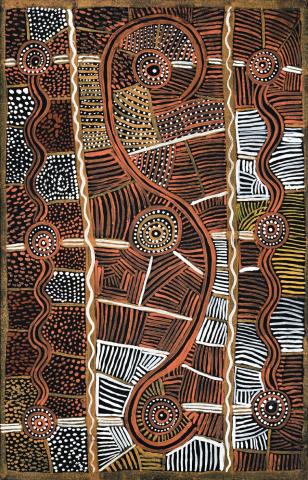WATER STORY (VERSION 7), 1972
LONG JACK PHILLIPUS TJAKAMARRA
synthetic polymer powder paint and PVA on composition board
46.5 x 30.0 cm
Painted in early 1972 at Papunya, Northern Territory
Stuart Art Centre, Alice Springs (painting 29, consignment 12)
Private collection, South Australia.
This painting is accompanied by documentation from Stuart Art Centre, Alice Springs (catalogue number 12029)
Bardon, G. and Bardon, J., Papunya, A Place Made After the Story: The Beginnings of the Western Desert Painting Movement, The Miegunyah Press, Melbourne, 2004, p. 173 for an illustration of the original field notes and drawing by Geoffrey Bardon. The annotated field notes depict the pattern variations for running water, waterholes, body paint designs and people (Men) dancing.
For a discussion of the Water Dreaming theme see Bardon and Bardon, 2004, p. 49, 53 and 84 and for other examples by the artist depicting the Water Dreaming see pp. 171-173
Geoff Bardon records that ‘Water Dreamings as a concept was seemingly a matter of significant and ritual celebration and often secret’, which contrasts with more secular subject matter like bush tucker stories. Symmetrical designs form the patterns and motifs of Tjakamarra's Water Story (version 7). Waterholes, indicated by roundels, are connected by running water shown in the painting as undulating lines joining each roundel. The sweeping arched segment running vertically through the centre of the painting represents men dancing while the dotting clusters with associated short bars represents body paint for the Water Men who are decorated for ritual celebration.1
Long Jack Phillipus Tjakamarra was part of the Papunya Community from 1962. He was employed as a groundsman and was a member of the community council. A deeply religious man, he was both a missionary and pastor for the Western Desert People and learned in traditional culture. In 1971 Tjakamarra, along with Billy Stockman, painted small murals around the Papunya School preceding the major Honey Ant murals collaboration by Papunya artists. These early works were highly iconographic often made up of simple geometric shapes, such as roundels, ovoid forms and crescent shapes. The classic water dreaming design of roundels linked by meandering lines was evident in the earliest of the Papunya boards. Artists such as Jonny Warangkula Tjupurrula, Charlie Tararu Tjungurrayi, Old Walter Tjampitjinpa together with Long Jack Phillipus Tjakamarra all executed versions of the Water Dreaming. The ability to find water in a desert environment is paramount to survival, and the knowledge of where springs, rockholes and other sources of water were was an indication of importance. Consequently, Water Dreaming stories were secret and only available to initiated men of senior standing.
Of the 40 founding painters, known as the painting men, of the Western Desert School, only three remain. Long Jack Phillipus Tjakamarra began painting for Papunya Tula Artists at its inception in 1973 and went on to become the organization's Chairman in the early 1990s.
1 Bardon, G. and Bardon, J., Papunya, A Place Made After the Story: The Beginnings of the Western Desert Painting Movement, The Miegunyah Press, Melbourne, 2004, p. 49
